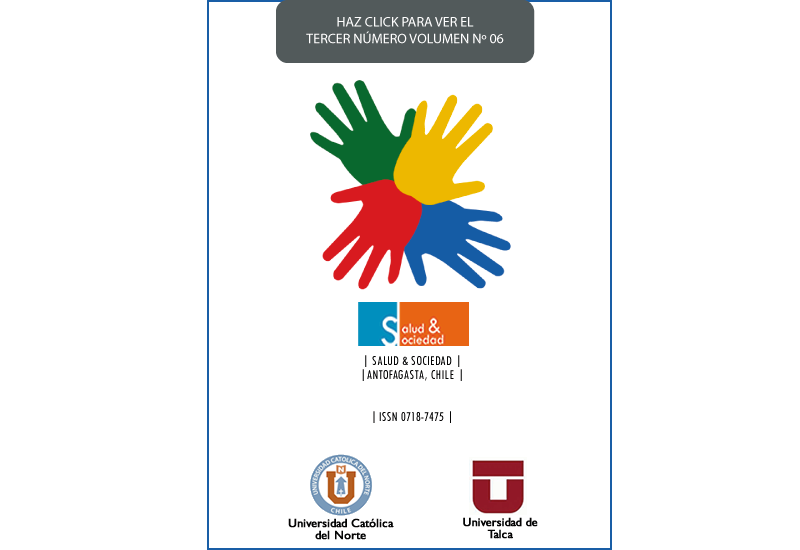Análisis exploratorio de modelos de ecuaciones estructurales sobre la escala de resiliencia de Connor y Davidson (CD-RISC) en Chile y España
DOI:
https://doi.org/10.22199/S07187475.2015.0003.00004Palabras clave:
Resiliencia, CD-Risc, Estructura factorial, Resilience, factorial structure,Resumen
Introducción: La resiliencia es el proceso de negociación, gestión y adaptación a las fuentes significativas de estrés o trauma. La CD-RISC es uno de los instrumentos para la evaluación de la resiliencia más utilizados, con diversos estudios sobre sus propiedades psicométricas en una gran variedad de países. Pese a ello, aun no existe consenso acerca de la estructura interna de la escala. Objetivo: modelar simultáneamente la comunalidad y las especificidades presentes en la escala, a fin de alcanzar una visión completa de la estructura dimensional de la CD-RISC en muestras distintas. Método: analizar las respuestas a la CD-RISC en muestras independientes originarias de Chile (n=376) y España (n=300), a fin de comprobar la estabilidad y solidez del modelo sobre muestras demográficamente similares pero pertenecientes a dos países distintos. Resultados: la CD-RISC en su totalidad es fuertemente unidimensional. El factor general fue estable entre ambas muestras, y explicó la mayor parte de la varianza fiable de los ítems. Después de parcializar el efecto de la dimensión general, las facetas no contribuyeron apenas a la medida, y fueron métricamente inestables entre ambas muestras. La excepción fue la faceta Espiritualidad, que resultó el único factor específico estable en ambas muestras. No obstante, su pobre definición en la CD-RISC (sólo dos ítems) impide llegar a conclusiones sobre la naturaleza substantiva del factor espiritualidad. Conclusiones: Las dimensiones de resiliencia no son demostrables desde un punto de vista psicométrico, por lo que tiene poco o ningún sentido utilizar las subescalas en forma de puntuaciones específicas, en cuanto que empíricamente no se diferencian entre sí.
Introduction: Resilience has to do with dealing, negotiating and adapting to significant sources of stress or trauma. CD-RISC is one of the most common tools around the world to assess resilience, with a plethora of studies about their psychometric properties. Yet, there is no agreement regarding the internal structure of this scale. Objective: To apply simultaneously in two different samples the commonality and features of the CD-RISC in order to have a general vision of the dimensional structure of this scale by assessing its stability and solidity. Method: Answers to the CD-RISC from two different samples (Chile, n=376; Spain, n=300) were analyzed. Results: The CD-RISC is a strong one-dimensional scale. The general factor proved to be stable in both samples. That explains a reliable variance in all items. After being partial about the effect of the general dimension, the facets showed a different reality. They were metrically unstable in both samples. The Spiritual Facet was an exception, being the only stable specific factor in both samples. However, the poor definition of the spiritual factor (only two items) in the CD-RISC is not enough to reach conclusions about its substantive nature. Conclusions: From a psychometrical point of view, dimensions of resilience cannot be demonstrated. This means using sub-scales to find specific punctuations is pointless because they are empirically similar.
Citas
Baldasaro, R.E., Shanahan, M.J., & Bauer, D.J. (2012). Psychometric properties of the Mini-IPIP in a large, nationally representative sample of young adults. Journal of Personality Assessment, 95(1), 74-84.
Bobes, J., Bascaran, M.T., García-Portilla, M.P., Bousoño, M., Sáiz, P.A., & Wallance, D.H. (2001). Banco de instrumentos básicos de psiquiatría clínica. Barcelona: Psquiatría ED.
Bobes, J., Bascaran, M.T., García-Portilla, M.P., Bousoño, M., Sáiz, P.A., & Wallance, D.H. (2008). Banco de instrumentos básicos de psiquiatría clínica. Barcelona: Psquiatría ED.
Browne, M.W., & Cudeck, R. (1992). Alternative ways of assessing model fit. Sociological Methods & Research, 21, 230-258.
Brunner, M., Nagy, G., & Wilhelm, O. (2012). A tutorial on hierarchically structured constructs. Journal of Personality, 80(4), 796-846.
Burns, G. L., Walsh, J. A., Servera, M., Lorenzo-Seva, U., Cardo, E., & Rodríguez-Fornells, A. (2013). Construct validity of ADHD/ODD rating scales: Recommendations for the evaluation of forthcoming DSM-V ADHD/ODD scales. Journal of Abnormal Child Psychology, 41(1), 15- 26.
Burns, R.A., & Anstey, K.J. (2010). The Connor-Davidson Resilience Scale (CD-RISC): Testing the invariance of a uni-dimensional resilience measure that is independent of positive and negative affect. Personality and Individual Differences, 48, 527-531.
Campbell-Sills, L., & Stein, M. B. (2007). Psychometric analysis and refinement of the Connor-Davidson Resilience Scale (CD-RISC): Validation of a 10- item measure of resilience. Journal of Traumatic Stress, 20, 1019-1028.
Cattell, R.B., & Baggaley, A.R. (1960). The salient variable similarity index for factor matching. The British Journal of Statistical Psychology, 13(1), 33-46.
Connor, K.M., & Davidson, J.R.T. (2003). Development of a new resilience scale: The Connor-Davidson resilience scale (CD-RISC). Depress Anxiety, 18(2), 76- 82.
DeYoung, C.G., Quilty, L.C., & Peterson, J.B. (2007). Between facets and domains: 10 aspects of the big five. Journal of Personality and Social Psychology, 93(5), 880-896.
Donellan, M.B., Oswald, F.L., Baird, B.M., & Lucas, R.E. (2006). The Mini-IPIP scales: Tiny-yet-effective measures of the big five factors of personality. Psychological Assessment. 18(2), 192-203.
Friborg, O., Hjemdal, O., Rosenvinge, J.H., & Martinussen, M. (2003). A new rating scale for adult resilience: What are the central protective resources behind healthy adjustment? International Journal of Methods in Psychiatric Research, 12, 65-76.
Friborg, O., Barlaug, D., Martinussen, M., Rosenvinge, J.H., & Hjemdal, O. (2005). Resilience in relation to personality and intelligence. International Journal of Methods in Psychiatric Research, 14(1), 29-42.
Fu, C., Leoutsakos, J.M., & Underwood, C. (2013). Moderating effects of a postdisaster intervention on risk and resilience factors associated with posttraumatic stress disorder in Chinese children. Journal of Traumatic Stress, 26, 663-670.
Fujikawa, M., Lee, E.J., Chan, F., Catalano, D., Hunter, C., Bengtson, K., & Rahimi, M. (2013). The Connor-Davidson Resilience Scale as a positive psychology measure for people with spinal cord injuries. Rehabilitation Research, Policy, and Education, 27, 213-222.
Gillespie, B.M., Chaboyer, W., Wallis, M., & Grimbeek, P. (2007). Resilience in the operating room: Developing and testing of a resilience model. Journal of Advanced Nursing, 59(4), 427-438.
Green, K.T., Hayward, L.C., Williams, A.M., Dennis, P.A., Bryan, B.C., Taber, K.H., Mid-Atlantic Mental Illness Research, Education and Clinical Center Workgroup, Davidson, J.R.T., Beckham, J.C., & Calhoun, P.S. (2014). Examining the factor structure of the Connor–Davidson Resilience Scale (CD-RISC) in a post-9/11 U.S. military veteran sample. Assessment, 21(4), 43-451.
Gucciardi, D.F., Jackson, B., Coulter, T.J., & Mallett, C.J. (2011). The ConnorsDavidson Resilience Scale (CD-RISC): Dimensionality and age-related measurement invariance with Australian cricketers. Psychology of Sport and Exercise, 12, 423-433.
Holzinger, K.J., & Swineford, F. (1937). The bi-factor method. Psychometrika, 2(1), 41-54.
Hu, L., & Bentler, P.M. (1999). Cutoff criteria for fit indexes in covariance structure analysis: Conventional criteria versus new alternatives. Structural Equation Modeling, 6, 1-55.
Jorgensen, I.E., & Seedat, S. (2008). Factor structure of the Connor-Davidson Resilience Scale in South African adolescents. International Journal of Adolescent Medicine and Health, 20, 23-32.
Karairmak, O. (2010). Establishing the psychometric qualities of the ConnorDavidson Resilience Scale (CD-RISC) using exploratory and confirmatory factor analysis in a trauma survivor sample. Psychiatry Research, 179, 350-356.
Khoshouei, M.S. (2009). Psychometric evaluation of the Connor-Davidson Resilience Scale (CD-RISC) using iranian students. International Journal of Testing, 9(1), 60-66.
Lamond, A.J., Depp, C., Allison, M., Langer, R., Reichstadt, J., Moore, D.J., Golshan, S., Ganiats, T.G., & Jeste, D.V. (2008). Measurement and predictors of resilience among community-dwelling older women. Journal of Psychiatric Research, 43(2), 148-154.
Lorenzo-Seva, U., & Ten Berge, J.M.F. (2006). Tucker’s congruence coefficient as a meaningful index of factor similarity. Methodology: European Journal of Research Methods for the Behavioral and Social Sciences, 2(2), 57-64.
Marsh, H.W., & Hau, K. (1996). Assessing goodness of fit: Is parsimony always desirable? The Journal of Experimental Education, 64, 364-390.
Marsh, H.W., Morin, A.J., Parker, P.D., & Kaur, G. (2014). Exploratory structural equation modeling: An integration of the best features of exploratory and confirmatory factor analysis. Annual Review of Clinical Psychology, 10, 85-110.
Menezes, V.A., Fernandez, B., Hernandez, L., Ramos, F., & Contador, I. (2006). Resiliencia y el modelo burnoutengagement en cuidadores formales de ancianos. Psicothema, 18(4), 791-796.
Morin, A. J., Arens, A. K., & Marsh, H. W. (2015). A bifactor exploratory structural equation modeling framework for the identification of distinct sources of construct-relevant psychometric multidimensionality. Structural Equation Modeling: A Multidisciplinary Journal, (ahead-of-print), 1-24.
Muthén, L.K., & Muthén, B.O. (2014). Mplus user’s guide (7th ed.). Los Angeles, CA: Muthén & Muthén.
Notario-Pacheco, B., Solera-Martinez, M., Serrano-Parra, M.D., BartolomeGutierrez, R., Garcia-Campayo, J., Martinez-Vizcaino, V. (2011). Reliability and validity of the spanish version of the 10-item Connor-Davidson Resilience Scale (10-item CD-RISC) in young adults. Health and Quality of Life Outcomes, 9, 63.
Reise, S.P. (2012). The rediscovery of bifactor measurement models. Multivariate Behavioral Research, 47(5), 667-696.
Rios, J., & Wells, C. (2014). Validity evidence based on internal structure. Psicothema, 26(1), 108-116.
Sarubin, N., Wolf, M., Giegling, I., Hilbert, S., Naumann, F., Gutt, D., Jobst, A., Sabaß, L., Falkai, P., Rujescu, D., Bu?hner, M., & Padberg, F. (2015). Neuroticism and extraversion as mediators between positive/negative life events and resilience. Personality and Individual Differences, 82, 93-198.
Schmitt, T.A., & Sass, D.A. (2011). Rotation criteria and hypothesis testing for exploratory factor analysis: Implications for factor pattern loadings and interfactor correlations. Educational & Psychological Measurement, 71, 95-113.
Serrano-Parra, M.D., Garrido-Abejar, M., Notario-Pacheco, B., Bartolome Gutierrez, R., Solera-Martinez, M., & Martinez-Vizcaino, V. (2011). Validez de la Escala de Resiliencia de Connor Davidson (CD-RISC) en una población de mayores entre 60 y 75 años. International Journal of Psychological Research, 5(2), 49-57.
Singh, K., & Yu, X. (2010). Psychometric evaluation of the Connor-Davidson Resilience Scale (CD-RISC) in a sample of indian students. Journal of Psychology, 1(1), 23-30.
Tucker, L.R. (1951). A method for synthesis of factor analysis studies (Personnel Research Section Report No. 984). Washington, DC: Department of the Army.
Thonrdike, R.L. (1994). g. Intelligence, 19, 45-155.
Watkins, M.W. (2005). Invariance [Computer software]. Phoenix, AZ: Ed & Psych Associates.
Windle, G. (2011). What is resilience? A review and concept analysis. Reviews in Clinical Gerontology, 21, 151-169.
Windle, G., Bennet, K.M., & Noyes, J. (2011). A methodological review of resilience measurement scales. Health and Quality of life outcomes, 9, 8.
Yu, X., Lau, J.T.F., Mak, W.W.S., Zhang, J., Lui, W.W.S., & Zhang, J. (2011). Factor structure and psychometric properties of the Connor-Davidson Resilience Scale among chinese adolescents. Comprehensive Psychiatry, 52, 218-224.
Yu, X., & Zhang, J. (2007). Factor analysis and psychometric evaluation of the Connor-Davidson Resilience Scale (CD-RISC) with chinese people. Social Behavior and Personality, 35, 19-30.
Zinbarg, R.E., Revelle, W., Yovel, I., Li, W. (2005). Cronbach’s alpha, Revelle’s beta, and McDonald’s omegah: Their relations with each other and two alternative conceptualizations of reliability. Psychometrika, 70, 123–133.
Publicado
Cómo citar
Número
Sección
Los autores continúan como propietarios de sus trabajos, y pueden volver a publicar sus artículos en otro medio sin tener que solicitar autorización, siempre y cuando indiquen que el trabajo fue publicado originariamente en Revista Salud & Sociedad (ISSNe:0718-7475).



_(1).png)





